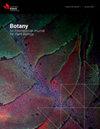大的植物能产出更多更好的种子和幼苗吗?在一种球形仙人掌Wigginsia sessiliflora上验证这一假设。
IF 1.3
4区 生物学
Q3 PLANT SCIENCES
引用次数: 1
摘要
在繁殖期植物中,随着植株大小的增加,预计分配给繁殖的数量会增加。本研究的目的是分析阿根廷中部生长缓慢的球形物种无柄威金斯(仙人掌科)的植物直径与总种子质量、种子数量、平均种子质量、百分比和平均发芽时间(MGT)以及幼苗大小和形状的关系。在n185个体的群体中测量植物直径,并收集果实。我们对所有种子进行计数以获得种子数量,并称重以获得种子质量和总种子质量。种子发芽并收集发芽率和MGT数据。我们还测量了幼苗的大小(高度和宽度)和形状(高度/宽度关系)。54%的植物不结果实。植株直径与果实数量、总种子质量和种子数量呈单峰相关,即中等大小的植株表现出最高的值。幼苗的高度和形状与植株直径呈正相关。令人惊讶的是,植物直径与繁殖产量呈单峰关系。随着植物的生长,表面积比降低,这意味着呼吸损失将高于光合能力的增加;因此,可用于再现的资源可能更少。本文章由计算机程序翻译,如有差异,请以英文原文为准。
Do larger plants produce more and better seeds and seedlings? Testing the hypothesis in a globose cactus, Wigginsia sessiliflora.
In iteroparous plants, an increase in allocation to reproduction is expected with increasing plant size. The aim of this study was to analyze how plant diameter is related to total produced seed mass, seed number, mean seed mass, percentage and mean germination time (MGT), and seedling size and shape in Wigginsia sessiliflora (Cactaceae), a slow-growing globose species from central Argentina. Plant diameter was measured in a population of n185 individuals, and fruits were collected. We counted all seeds to obtain seed number, and weighed them to get seed mass and total seed mass. Seeds were germinated and data of germination percentage and MGT were collected. We also measured the size (height and width) and shape of seedlings (height/width relationship). Fifty four percent of the plants did not produce fruits. Plant diameter was unimodally related to fruit number, total seed mass, and seed number, i.e. intermediate-sized plants presented the highest values. Height and shape of seedlings were positively related to plant diameter. Surprisingly, plant diameter was related in a unimodal way to reproductive outputs. As plants grow, surface-volume ratio decreases, meaning that respiratory losses would be higher than the increase in photosynthetic capacity; therefore, fewer resources may be available for reproduction.
求助全文
通过发布文献求助,成功后即可免费获取论文全文。
去求助
来源期刊

Botany
生物-植物科学
CiteScore
2.20
自引率
9.10%
发文量
48
期刊介绍:
Botany features comprehensive research articles and notes in all segments of plant sciences, including cell and molecular biology, ecology, mycology and plant-microbe interactions, phycology, physiology and biochemistry, structure and development, genetics, systematics, and phytogeography. It also publishes methods, commentary, and review articles on topics of current interest, contributed by internationally recognized scientists.
 求助内容:
求助内容: 应助结果提醒方式:
应助结果提醒方式:


